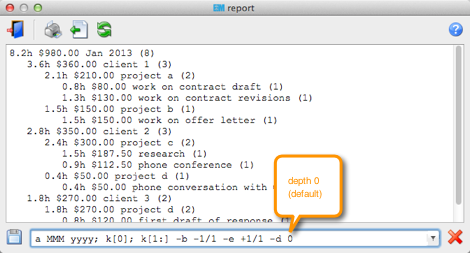
etm supports creating, printing and exporting reports. Either click on the report icon in the main window or press Control-R to open the report dialog.
Usage: <report type character> <groupby setting> [report options]A report specification is created by entering a report type character followed by a groupby setting and, perhaps, by one or more report options. Together, the type character, groupby setting and options determine which items will appear in the report and how they will be organized and displayed.
There are two possible report type characters, a and c:
a: action or accounting report. A report of expenditures of time and money recorded in actions with output formatted using action_template computations and expansions.
c: custom report. Any item types but without action_template computations and expansions.
Available action_template expansions for action reports include:
!label! the item or group label.
!count! the number of children represented in the reported item or group.
!minutes! the total time from @e entries in minutes rounded up using the setting for action_minutes.
!hours! if action_minutes = 1, the time in hours and minutes. Otherwise, the time in floating point hours.
!value! the billing value of the rounded total time. Requires an action entry such as @v br1 and a setting for action_rates.
!expense! the total expense from @x entries.
!charge! the billing value of the total expense. Requires an action entry such as @w mu1 and a setting for action_markups.
!total! the sum of !value! and !charge!.
Note: when aggregating amounts in action reports, billing and markup rates are applied first to times and expenses for individual actions and the resulting amounts are then aggregated. Similarly, when times are rounded up, the rounding is done for individual actions and the results are then aggregated.
See help/preferences for further details about setting action_template.
You can select a report specification from a list of saved specifications, modify an existing specification or create an entirely new specification. Clicking on the create report icon or pressing Control-R will create a report based on the current specification.
When you edit an existing specification, the background color of the entry field will change to yellow to indicate that this is a new, as yet unsaved specification. Pressing Return will add the new specification temporarily to the list without affecting the original specification.
If the current specification has been modified, then deleting it by clicking on the delete icon or pressing Control-D will replace the modified specification with the original. If the current specification has not been modified, then deleting it will temporarily remove it from the list.
When temporary changes have been made to the list, the save button will be enabled and you can either click on this button or press Control-S to save the changes. If you attempt to close the reports dialog while there are unsaved changes, you will be given the opportunity to save them.
A semicolon separated list that determines how items will be grouped and sorted. Possible elements include date specifications and elements from
context
file path
keyword
tag
user
A date specification is either:
or a combination of one or more of the following:
2-digit year
4-digit year
month: 1 - 12
month: 01 - 12
locale specific abbreviated month name: Jan - Dec
locale specific month name: January - December
month day: 1 - 31
month day: 01 - 31
locale specific abbreviated week day: Mon - Sun
locale specific week day: Monday - Sunday
For example, c ddd, MMM d yyyy would group by year, month and day together to give output such as
Fri, Apr 1 2011
items for April 1
Sat, Apr 2 2011
items for April 2
...On the other hand, a w; u; k[0]; k[1:] would group by week number, user and keywords to give output such as
13.1) Week 14: Mar 31 - Apr 6, 2014
6.3) agent 1
1.3) client 1
1.3) project 2
1.3) Activity (12)
5) client 2
4.5) project 1
4.5) Activity (21)
0.5) project 2
0.5) Activity (22)
6.8) agent 2
2.2) client 1
2.2) project 2
2.2) Activity (13)
4.6) client 2
3.9) project 1
3.9) Activity (23)
0.7) project 2
0.7) Activity (23)As another example, c t -t tag 1, !tag 3 would group by tag showing items that have a tag matching tag 1 but not one matching tag 3.
With the heirarchial elements, file path and keyword, it is possible to use parts of the element as well as the whole. Consider, for example, the file path A/B/C with the components [A, B, C]. Then for this file path:
f[0] = A
f[:2] = A/B
f[2:] = C
f = A/B/CSuppose that keywords have the format client:project. Then c MMM yyyy; k[0]; k[1] would group by year and month, then client and finally project to give output such as
Apr 2011
client a
project 1
items for client a project 1 for April
project 2
items for client a project 2 for April
client b
project i
items for client b project i for April
...Items that are missing an element specified in groupby will be omitted from the output. E.g., undated tasks and notes will be omitted when a date specification is included, items without keywords will be omitted when k is included and so forth.
When a date specification is not included in groupby, undated notes and tasks will be potentially included, but only those instances of dated items that correspond to the relevant datetime of the item of the item will be included, where the relevant datetime is the past due date for any past due tasks, the starting datetime for any non-repeating item and the datetime of the next instance for any repeating item.
Within groups, items are automatically sorted by date, type and time.
Report options are listed below. Report types c supports all options except -d. Report type a supports all options except -o and -h.
Fuzzy parsed date. Limit the display of dated items to those with datetimes falling on or after this datetime. Relative day and month expressions can also be used so that, for example, -b -14 would begin 14 days before the current date and -b -1/1 would begin on the first day of the previous month. It is also possible to add (or subtract) a time period from the fuzzy date, e.g., -b mon + 7d would begin with the second Monday falling on or after today. Default: None.
Regular expression. Limit the display to items with contexts matching CONTEXT (ignoring case). Prepend an exclamation mark, i.e., use !CONTEXT rather than CONTEXT, to limit the display to items which do NOT have contexts matching CONTEXT.
The default, -d 0, includes all outline levels. Use -d 1 to include only level 1, -d 2 to include levels 1 and 2 and so forth. For example, a report that appears as follows with the default, -d 0:

Exporting this report (CSV format) would give:
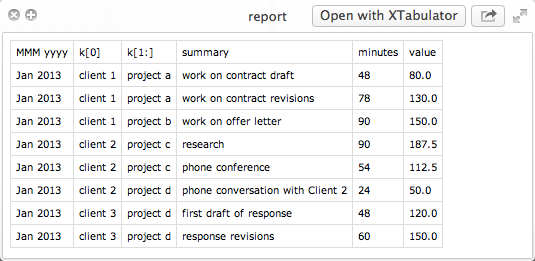
With -d 3, these would change to
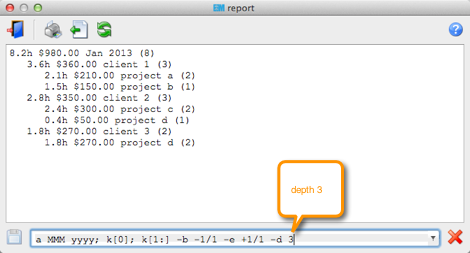
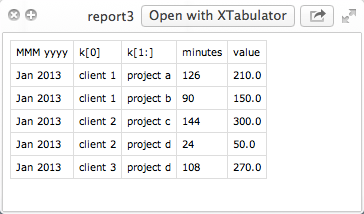
and, with -d 2 to
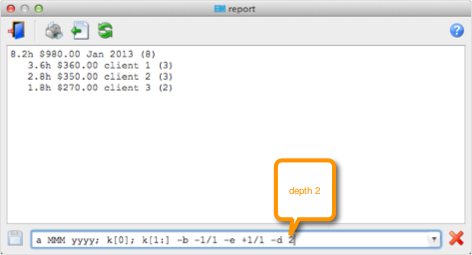
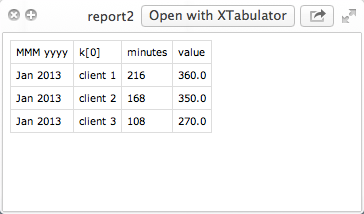
In this example, the relevant settings from etm.cfg are
action_minutes: 6
action_rates:
default: 100.0
br1: 125.0
br2: 150.0
action_template: '!hours!h $!value! !label! (!count!)'The default action_rate is used for client 1, br1 for client 2 and br3 for client 3.
Fuzzy parsed date. Limit the display of dated items to those with datetimes falling before this datetime. As with BEGIN_DATE relative month expressions can be used so that, for example, -b -1/1 -e 1 would include all items from the previous month. As with -b, period strings can be appended, e.g., -b mon -e mon + 7d would include items from the week that begins with the first Monday falling on or after today. Default: None.
Regular expression. Limit the display to items from files whose paths match FILE (ignoring case). Prepend an exclamation mark, i.e., use !FILE rather than FILE, to limit the display to items from files whose path does NOT match FILE.
0, 1 or 2. -h 2 uses all possible colors for leaf fonts, -h 1 uses red for past due items and black for everything else and -h 0 uses black for everything. The default is taken from the setting for colors in emt.cfg.
Regular expression. Limit the display to items with contexts matching KEYWORD (ignoring case). Prepend an exclamation mark, i.e., use !KEYWORD rather than KEYWORD, to limit the display to items which do NOT have keywords matching KEYWORD.
Regular expression. Limit the display to items with location matching LOCATION (ignoring case). Prepend an exclamation mark, i.e., use !LOCATION rather than LOCATION, to limit the display to items which do NOT have a location that matches LOCATION.
String. Show/hide a)ctions, d)elegated tasks, e)vents, g)roup tasks, n)otes, o)ccasions and/or other t)asks. For example, -o on would show everything except occasions and notes and -o !on would show only occasions and notes.
Regular expression. Limit the display to items containing SUMMARY (ignoring case) in the item summary. Prepend an exclamation mark, i.e., use !SUMMARY rather than SUMMARY, to limit the display to items which do NOT contain SUMMARY in the summary.
Comma separated list of case insensitive regular expressions. E.g., use
-t tag1, !tag2to display items with one or more tags that match 'tag1' but none that match 'tag2'.
Regular expression. Limit the display to items with user matching USER (ignoring case). Prepend an exclamation mark, i.e., use !USER rather than USER, to limit the display to items which do NOT have a user that matches USER.
Integer. Limit the first column display width to this number of characters. Default: report_width1 in etm.cfg.
Integer. Limit the second column display width to this number of characters. Default: report_width2 in etm.cfg.